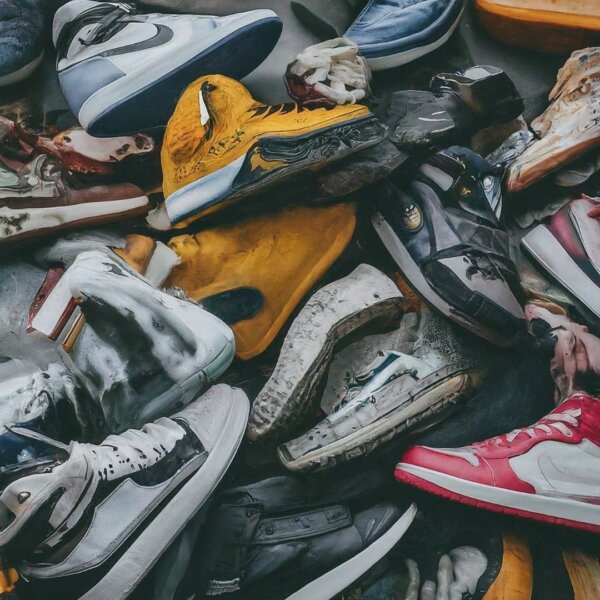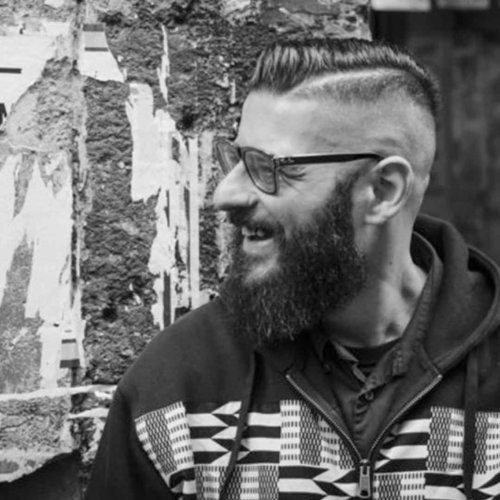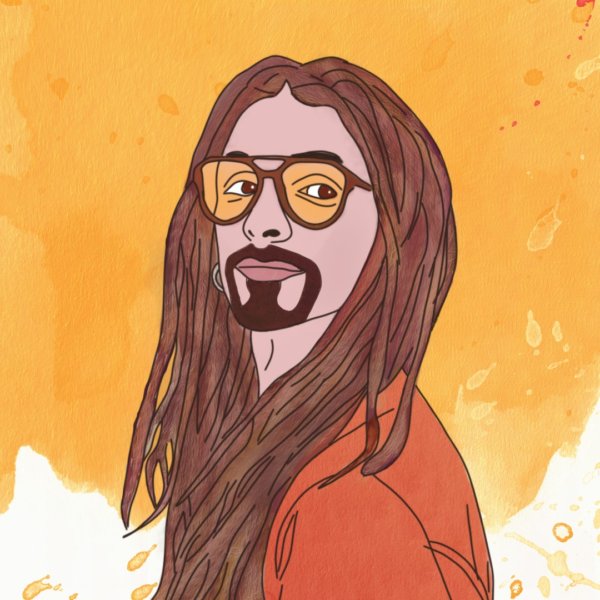Name a Legendary Rapper Without Crazy Sneaker Game. You Can’t.
When it comes to Streetwear fashion, we may picture baggy tracksuits, grillz, and chains. But one thing is certain: we always link Hip-Hop iconic sneakers to the genre’s history. And they just might just be the real MVPs of style.
Nearly all big sneaker names are linked to a Hip-Hop era, artist, or culture somehow. Think about it. Adidas Superstars and Run-DMC, Air Force 1s and Nelly, Kanye West and Yeezys, Michael Jordan and…well, Jordans.
Let’s take a trip at how the path of Hip-Hop Iconic Sneakers in History started, evolved, and continued.
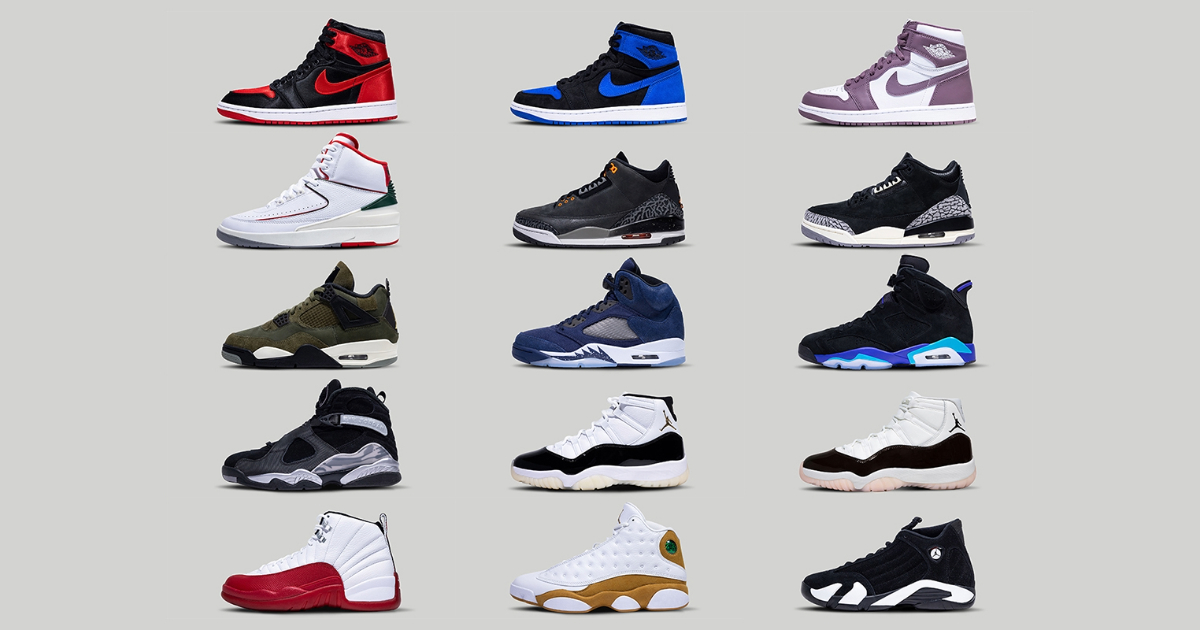
The evolution of Nike’s Jordan line through four decades.
There is a long way to go: the 1970s era
The story starts in the past century, in the urban inner cities of the United States, during the 1960s and 1970s. This is where we need to start looking to see the beginning of a global movement. The sneaker culture burgeoned within the vibrant backdrop of hip-hop, but before that street culture in the largest meaning of the word played a big role. Stemming from a fusion of sports, creativity, self-expression, and necessity, this cultural phenomenon rose in the mid to late Sixties.
Sneakers transcended mere footwear, being synonyms of frenzy activity and style. Brands like Pro-Keds, Chuck Taylor, K-Swiss, and Puma, gained prominence as their sneakers in the pulsating rhythm of city life. Often sneakers served as functional shoes, but more as canvases for self-expression and personalized designs.
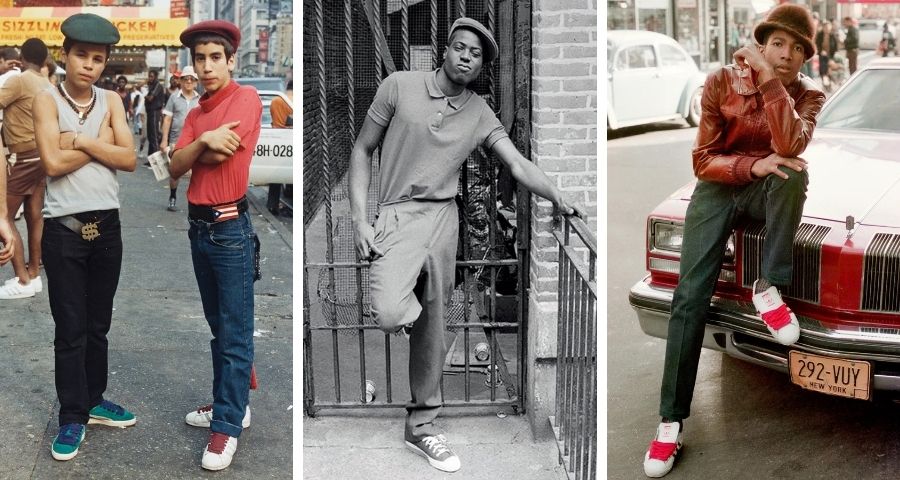
Iconic street shots by Jamel Shabazz in New York, the early 1980s
Sneaker culture in this era became a form of artistic expression, reflecting the resilience, creativity, and spirit of urban communities amidst challenging social and economic circumstances. This period laid the foundation for the enduring relationship between hip-hop culture and sneaker brands, shaping the trajectory of both industries for decades to come.
When the early adopters of Hip-Hop, like the aerosol writers and the b-boys breakdancing in the Bronx, were rocking styles they saw on their basketball heroes. Think about the iconic Adidas Superstar – originally a court crusher worn by legends like Kareem Abdul-Jabbar. These weren’t just footwear, they were a badge of connection to the stars of the game.
The same story goes for the legendary Clyde’s by Puma when it signed an endorsement agreement with basketball star Walt “Clyde” Frazier. The shoes were a b-boy staple in the late Seventies and early Eighties, and became famous as “the Suedes”. Clyde wanted a low shoe style to play, with a new colourway for every game. Because of this, the shoe was made out of suede, hence the name. Street kids used it to dance on the concrete.
Chris Gibbons, CEO of the sneaker marketplace Laced, says it all: “The popular sneakers we love today? They started as basketball shoes, adopted by hip-hop culture.” It makes sense, right? Fans wanted to rock the same gear as their idols, to feel part of their world. And that connection between athletes and musicians only grew stronger. These Hip-Hop iconic sneakers love affair is a two-way street.
But the bond between hip-hop and sneakers goes deeper than just sporting the same kicks as your favourite ballplayer. It’s about what those sneakers represent: success, power, and that hard-earned come-up story.
Nike’s Air Force 1 is a prime example. It’s a certified Hip-Hop iconic sneaker in its own right. These kicks became iconic thanks to rappers from New York, Philly, and other East Coast cities where the shoe represented a symbol for hustlers and street achievers. They weren’t about MJ dropping 50 points (although that would be impressive in any shoe), they were about everyday people making it big.
Since the moment Nike dropped them on the market, a long time has passed, and through the years the relationship between rap stars and hip-hop heads and sneakers has been on a wild ride. Rappers went from subtle trendsetters to walking billboards, and now they’re calling the shots. Fast forward to today, and rappers are leading the charge in sneaker design and trends. Athletes used to be the top tastemakers, but now it’s all about the mic-droppin’, rhyme-spitting fashion icons.
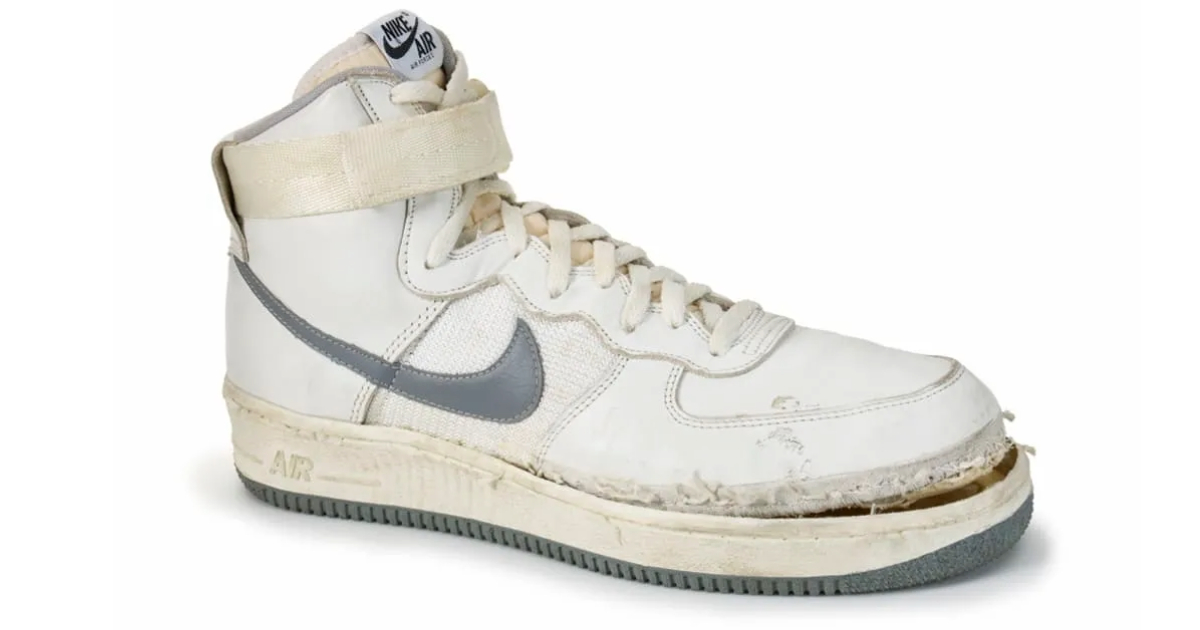
Original Air Force 1, 1982.
Long before A$AP Rocky was chilling in the front row at Paris Fashion Week as a brand consultant, Run-DMC was rocking their Adidas live at their concerts and on MTV. Before Kanye West got his Yeezy line, Jay-Z was making shoes with Reebok. The list of rappers who’ve influenced or designed sneakers is longer than a Kanye West rant – Nas, Wu-Tang Clan, Eminem, you name it.
From classics like “My Adidas”, “Nike” and “Air Force Ones” to the latest drops from Travis Scott and beyond, the history of Hip-Hop iconic sneakers keeps getting written, one fresh pair of kicks at a time. Let’s dive deeper into its past, shall we?
Blasting Off: 1986-1990
1985. LL Cool J, the hottest new rapper, sported fresh Air Jordan Is on the back of his debut album, “Radio.” It made perfect sense: a rising star rocking the kicks of a rising young athlete. LL was a charismatic magnet who could sell anything, but it was his Def Jam labelmates, Run-DMC, who would ignite the explosion of rap and sneakers as a cultural phenomenon.
The Birth of a Power Couple
Fast forward a year. Run-DMC were dominating the scene, and Adidas executive Angelo Anastasio spotted them breakdancing in their signature Adidas “rainsuits” – those slick three-striped tracksuits perfect for spinning on cardboard. But Anastasio had no idea of the group’s true power until a Madison Square Garden concert. Thousands of fans waved their Adidas in a sea of devotion. The potential was undeniable.
Anastasio offered a groundbreaking $1 million endorsement deal. It was unheard of. Suddenly, a brand was front and centre in a rap video – the Adidas Superstar getting its close-up in Run-DMC and Aerosmith’s smash, “Walk this Way”. Then came the ultimate co-sign: “My Adidas,” 1986 anthem, the first sneaker to get its rap song. Run-DMC ruled the rap world, and their Adidas Superstar was thriving.
This partnership was a game-changer for several reasons. First, it was a million-dollar bet on uncharted territory. No hip-hop act had ever landed such a deal, and no sneaker company had invested so heavily in the genre. But the German giant recognized the power rappers held over young audiences and cleverly tapped into a market their competitors missed.
Here’s what made Run-DMC so authentic: they wore their adidas everywhere – on stage, in videos, and on their Queens corner. Unlike earlier rappers who donned flashy leathers or African-inspired attire, Run-DMC kept it real. Their influence may have even been underestimated by adidas. Run-DMC single-handedly challenged Nike’s dominance, especially with Michael Jordan on the rise (his Jordan Is debuted in 1985, the same year as “My Adidas”).
From Arenas to Airwaves
By 1989, Jordans were stealing the scene in Spike Lee’s “Do the Right Thing.” Lee’s iconic Mars Blackmon commercials further cemented the bond between sports and entertainment. The lines between mainstream entertainment and sportswear were blurring so fast that, in 1990, MC Hammer scored a lucrative deal with British Knights.
Before Run-DMC, British Knights had tapped Kool Moe Dee and Public Enemy for product placement in MTV videos, but the Hammer deal was a whole new level. They signed him as a full-fledged endorser during his pop music reign. The company sponsored his tour, ran in-store events and contests, and plastered him across TV, print, and radio ads. Hammer rocketed British Knights into the mainstream, but sadly, the brand folded in 1992.
Near Misses: 1990-1996
The 1990s were a wild time for both sneakers and rap music. Rap was exploding in popularity, with the West Coast scene pushing boundaries and topping charts, even while facing heat from censors and authorities. Meanwhile, Michael Jordan was soaring to NBA superstardom, and his signature sneakers were becoming a must-have for any self-respecting baller (or wannabe baller).
But things took a dark turn in 1990. Sports Illustrated dropped their infamous “Your Sneakers or Your Life”cover story, highlighting the dangers associated with the growing sneaker obsession. The story even detailed the tragic death of a teenager over a pair of Jordan Vs. Yikes. Suddenly, Hip-Hop iconic sneakers were linked to gang violence and drug dealers, casting a dark cloud over the entire industry.
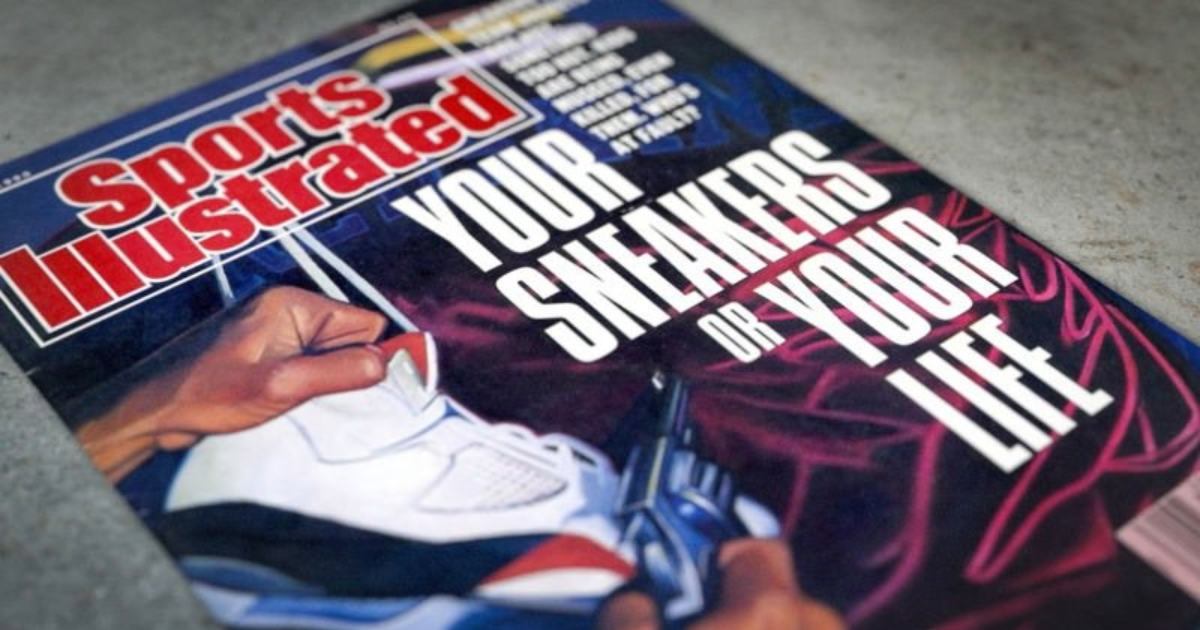
Sports Illustrated “Your Sneakers or Your Life” cover, 1990.
Sneaker Deals Gone Cold
This negative press made sneaker companies skittish about associating themselves with hip-hop. And Public Enemy’s politically charged lyrics weren’t exactly what corporations were looking for in an endorsement deal. Even Michael Jordan himself distanced himself from the scene, worried about drug money fueling the sneaker market.
The result? A surprising lack of sneaker endorsements for rappers during this golden age of hip-hop. Think about it – Snoop Dogg, Biggie, Tupac, Nas, A Tribe Called Quest – all these legends were coming onto the scene, but their kicks weren’t getting the official co-sign.
Now, hold up.
Just because there weren’t a ton of commercials doesn’t mean Hip-Hop iconic sneakers influence disappeared. In 1991, a true OG named Bobbito Garcia – DJ, sneakerhead, and member of the legendary Rock Steady Crew – penned a groundbreaking piece for The Source Magazine called “Confessions of a Sneaker Addict.” It wasn’t just an entertaining read, it was basically a crystal ball predicting the next 25 years of the sneaker industry. We’re talking exclusive retros, the rise of the Air Max Bubble – you name it, Bobbito called it.
This dude was basically dropping knowledge bombs in the holy grail of Hip-Hop magazines. And while discussing the greatest kicks ever, he championed the Air Force 1s – a shoe that, according to Bobbito, had a special connection to hip-hop, particularly in places like Philly and New York, where they were dubbed “Uptowns”.
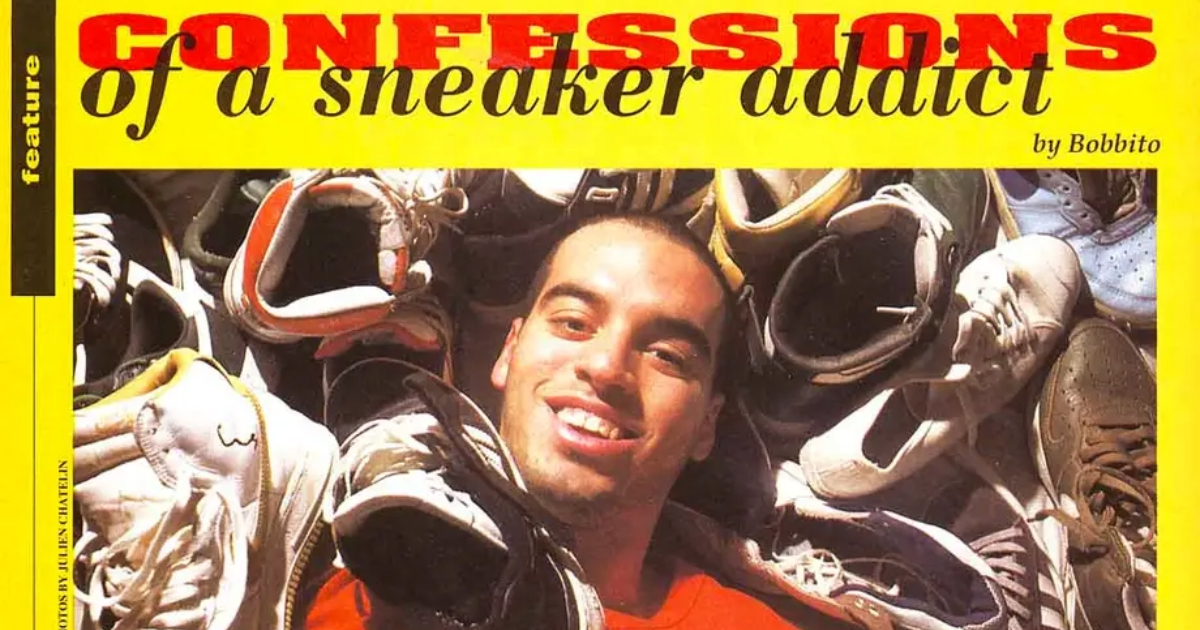
Bobbito Garcia feature for The Source Magazine called “Confessions of a Sneaker Addict”, 1991.
By 1992, rap’s influence even reached college basketball. The Michigan Fab Five, those swaggering freshmen led by Chris Webber and Jalen Rose took the nation by storm, rocking black sneakers, socks, and baggy shorts. Their whole vibe was undeniably influenced by the rappers of their era. Even today, rappers like Wale still credit the Fab Five as style icons.
So, even though the 90s weren’t exactly prime time for official Hip-Hop iconic Sneakers, the connection between the two cultures remained strong. It was a time of missed opportunities for sure, but the underground influence of hip-hop on sneaker culture continued to simmer, ready to explode in the years to come.
Hip-Hop Iconic Sneakers Go Platinum: 1996-2003
The late 90s and early 2000s were all about hip-hop’s total domination of the sneaker game. It wasn’t just about showing off anymore, rappers were calling the shots. Remember those days when parents couldn’t escape rap blaring from the radio? Yeah, that was this era. Rap music was everywhere, and rappers were becoming major players, not just on the charts, but in the world of fashion too. We’re talking Puff Daddy launching Sean John era.
This newfound influence trickled down to sneakers. Endorsements, once a thing of the past, came roaring back. Like LL Cool J’s iconic shoutout to FUBU in a GAP commercial that was a game-changer. It showed that hip-hop wasn’t some niche market anymore, it was influencing mainstream fashion in a big way.
With Michael Jordan on the verge of retirement, the sneaker world needed a new hero. Enter Allen Iverson, a basketball player who was the anti-Jordan. He wore baggy clothes, spoke his mind, and embodied the raw energy of hip-hop. It was a match made in sneaker heaven.
Reebok, recognizing Iverson’s potential, signed him up and launched the iconic “Question” shoe line. This wasn’t just another athlete endorsement, it was a cultural connection. Iverson’s success on the court, combined with his street cred, made the “Question” a massive hit. Reebok even gave him a lifetime contract, sealing the deal.
Things got even crazier in 2001. Iverson teamed up with The Trackmasters and rapper Jadakiss for a killer commercial promoting his new A5 shoe. It was a hit formula – hot beats, a charismatic athlete, and a killer shoe. They repeated the success story the following year with the A6.
Iverson wasn’t just a great player, he was a sneaker culture pioneer. His success with Reebok opened the door for a flood of rapper endorsements in the years to come.
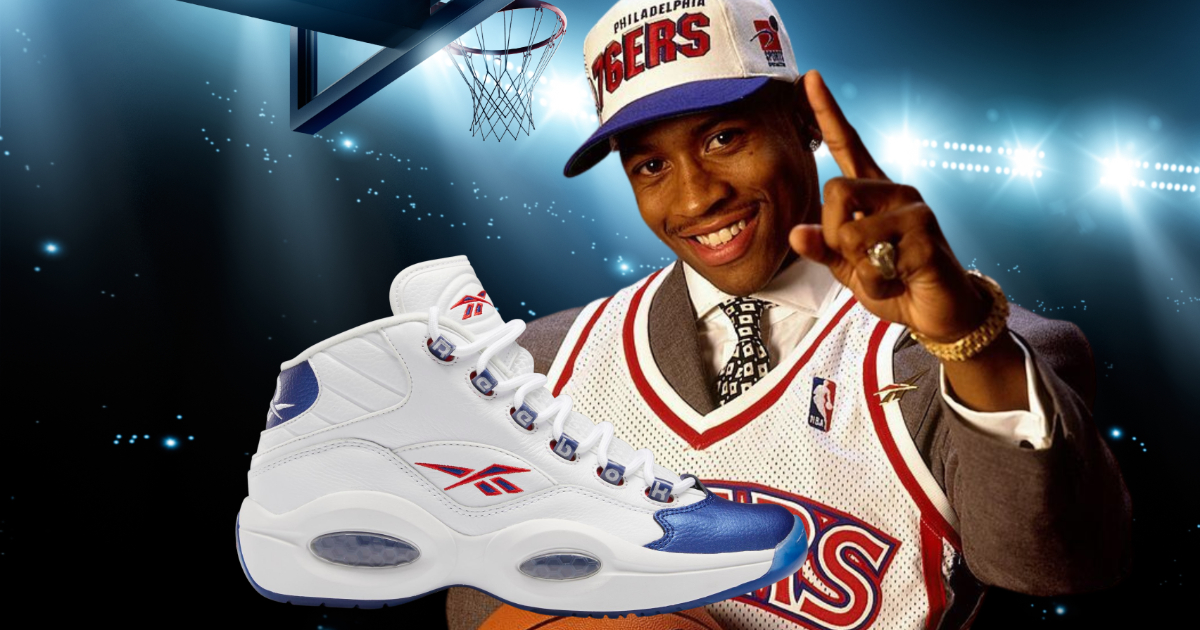
Allen Iverson and his Reebok “Blue Toe” Question sneaker.
The Rise of a Sneaker Anthem
Rappers weren’t just wearing sneakers, they were rapping about them too. In 2002, Nelly dropped his ode to the classic Air Force Ones, “Air Force Ones.” The video was a shrine to the shoe, featuring hundreds of pairs in every colour imaginable. Some might call it blatant product placement, but hey, it worked. The song perfectly captured the sneakerhead obsession – gotta have your fresh kicks, gotta keep a clean pair for special occasions, you know the drill.
By 2003, things got serious. Reebok, ever the trendsetter, signed endorsement deals with two of the biggest rappers in the world: Jay-Z and 50 Cent. This wasn’t just about athletes anymore. It was a bold move, a gamble that rappers could sell shoes just as well as ballers.
And Reebok was right. Jay-Z’s “S. Carter” shoe sold out in hours, proving that rappers could be sneaker superstars. 50 Cent’s “G-Unit by RBK” line was another hit, perfectly capturing his tough-guy persona.
This wasn’t a one-time thing. Reebok went on to sign other rappers, but none quite captured the magic of Jay-Z and 50 Cent. Their landmark deals, however, paved the way for future rapper-sneaker collaborations, forever changing the landscape of the industry.
That’s a bit of how the late 90s and early 2000s were a golden age for Hip-Hop iconic sneakers. Rappers weren’t just musicians anymore, they were cultural icons, tastemakers, and moguls.
Rappers Take the Wheel: Welcome to the Present Future
After Jay-Z and 50 Cent paved the way with their Reebok deals, rapper-sneaker collabs became the new hotness. Brands like Lugz, Fila, and even Questlove got in on the action, proving that rap was now the undisputed leader of sneaker culture – and everyone wanted a piece of the pie.
This wasn’t just a one-off thing, though. Pharrell Williams joined forces with Nigo to launch Billionaire Boys Club and Ice Cream, flooding the market with a wild array of colourful kicks thanks to Reebok (again). By 2011, Reebok took things a step further, making Swizz Beatz their creative director.
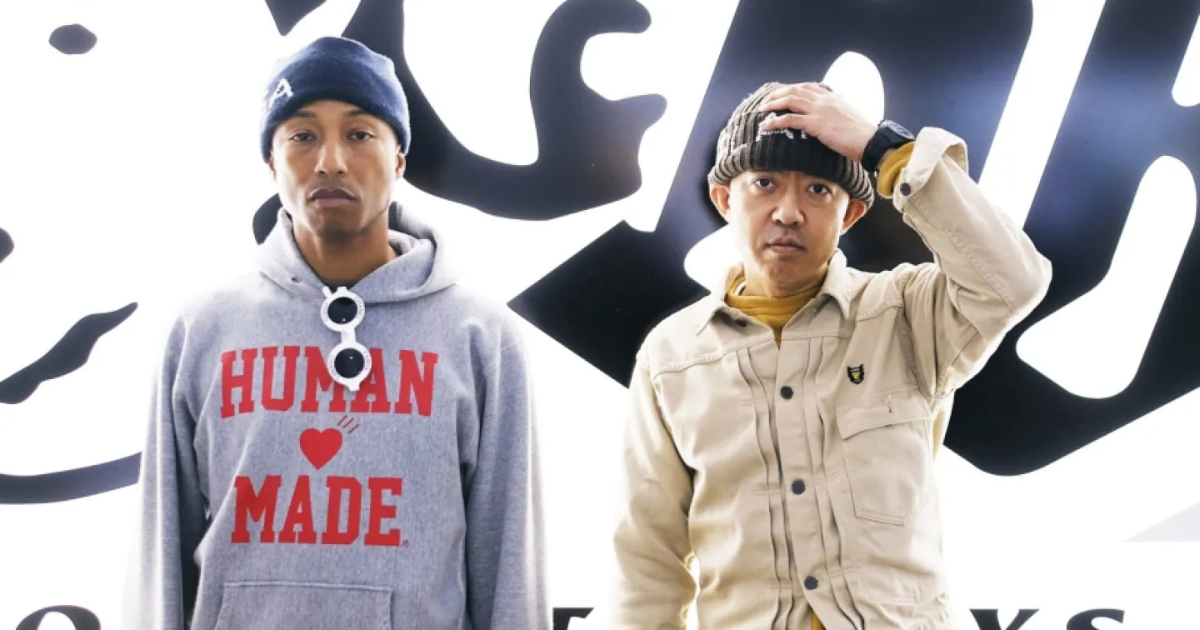
Pharrell Williams and Nigo attend the Opening Of Billionaire Boys Club Flagship, 2016.
Meanwhile, Kanye West’s star was on the rise. (Disclaimer: we do not support his crazy stunts or beliefs or whatever goes in that man’s head).
His debut album, “The College Dropout,” even got its special BAPE edition, marking Kanye’s official entry into the sneaker world. In 2009, he upped the ante with a collection of sneakers for Louis Vuitton, including the “Louis Vuitton Don” and the “Jaspers”. This move set the stage for something even bigger.
Kanye wasn’t satisfied with just slapping his name on existing designs. He craved creative control. In 2009, he convinced Nike to give him the unthinkable – his signature shoe, the Air Yeezy. This was a monumental moment – the first time Nike ever bestowed such an honour on a non-athlete. Designed by Kanye and Nike’s Mark Smith, the Air Yeezy was an instant smash, selling out in all three colourways faster than you could say “Yeezy.”
The success continued in 2012 with the Air Yeezy II, which also disappeared from shelves in a heartbeat. But things got complicated. Kanye wanted more freedom to design, and Nike wasn’t budging. This creative clash ultimately led to a split in 2013. However, Nike snuck in one last dig with the ultra-hyped “Red October” Yeezy II released later that year. Kind of a sneaky “last laugh” at the end of the Kanye-Nike saga.
February 2015 marked a new era. Kanye debuted his first shoe with Adidas, the Yeezy Boost 750. This collaboration was a game-changer. Unlike Nike, Adidas gave Kanye the freedom he craved to create his entire line. Every single Yeezy release since then has been a success story, solidifying Kanye’s massive influence on streetwear and sneakers Their relationship might be rocky now, but it still made an impact.
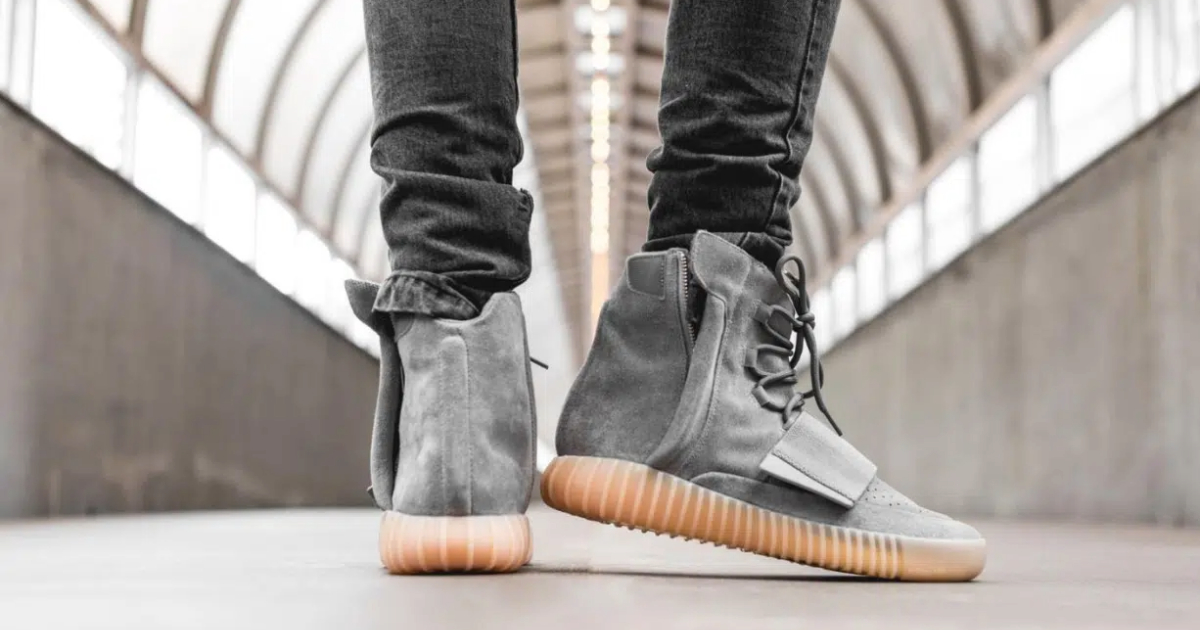
Kanye West and Adidas Yeezy Boost 750, 2015.
Pharrell, with his thriving Adidas line, joined the ones at the top. Consider also his recent appointment at the helm of Louis Vuitton, and you’ll see the perfect trajectory. Rappers had officially dethroned athletes as the ultimate tastemakers in the sneaker world. It’s no surprise that Under Armour followed suit, bringing in A$AP Rocky for a multifaceted partnership in 2017. The move, as Under Armour explains, allows Rocky to “explore new product avenues” – a fancy way of saying they’re giving him the power to influence their designs.
Even Nike, the brand that once hesitated with Kanye, acknowledged the power of rap. In 2017, to celebrate the 35th anniversary of the iconic Air Force 1, Nike entrusted the shoe’s redesign to five people, four out of five were deeply rooted in the rap and entertainment world.
There’s Kareem “Biggs” Burke, a Roc-A-Fella Records founder famous for buying mountains of Air Force 1s back in the day. He brought back the classic Roc-A-Fella Air Force 1 with its iconic logo. Travis Scott reimagined the design with a detachable swoosh and a cool tan sole. And finally, Virgil Abloh and Don C, two creative minds who rose to luxury streetwear fame, also put their spin on the legendary silhouette.
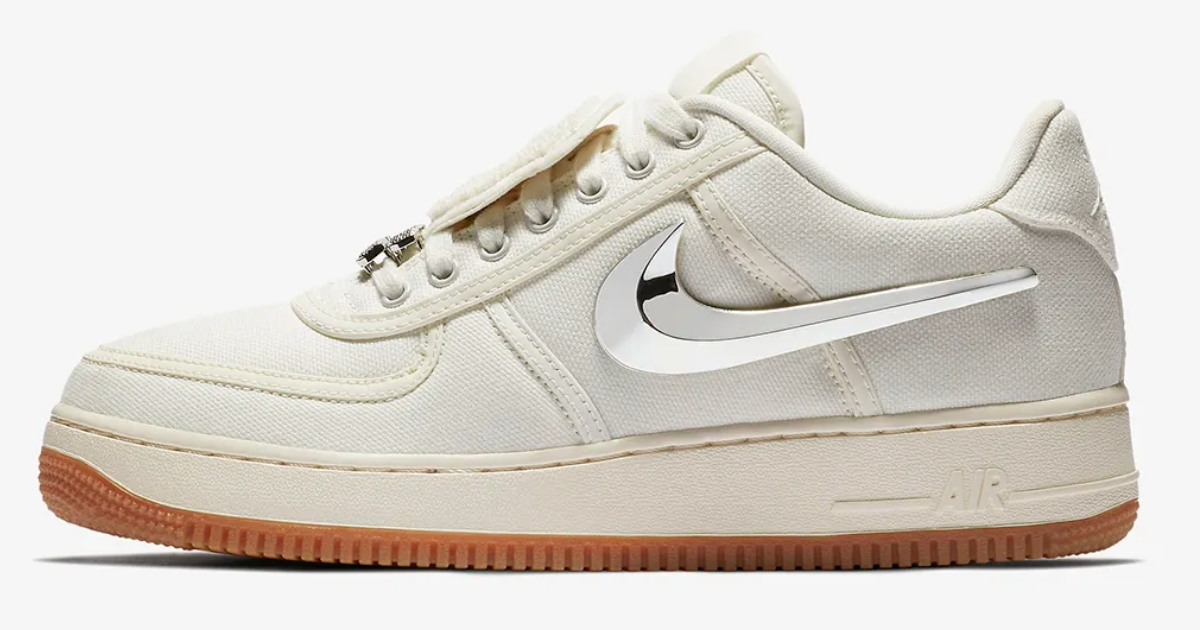
Travis Scott x Nike Air Force 1 Low “Sail”, 2017.
It’s a beautiful testament to rap’s enduring influence that brands when tasked with reinventing a classic, look towards the genre to create a buzz and keep things fresh.
Hip-Hop Iconic Sneakers are here for good
Thanks to the magic of Hip-Hop, the hottest kicks aren’t just about crossing over defenders, they’re about dropping the hottest beats.
Rappers are the new tastemakers, the ultimate hype machines. Guys like Drake and Travis Scott don’t just wear, endorse or design sneakers, they turn them into cultural phenomenons. They build anticipation like nobody’s business, leaving fans fiending for that limited-edition drop.
Here’s the thing: for many rappers, these shoes were once a symbol of success, something they hustled hard to afford. Now, the tables are turned. They’re designing their kicks, and kids everywhere are lining up to snag a piece of that rapper-approved swag.
It wasn’t always this way, though. Sneaker brands used to see rappers as a fad, a way to tap into a younger market. They never imagined these music icons would become the key players. But times have changed. Today, collaborating with a rapper isn’t a gamble, it’s a guaranteed win.
So, next time you see a kid rocking some limited-edition kicks with a rapper’s name on them, just remember: it’s not just about the shoes, it’s about the cultural shift that Hip-Hop iconic sneakers helped create.
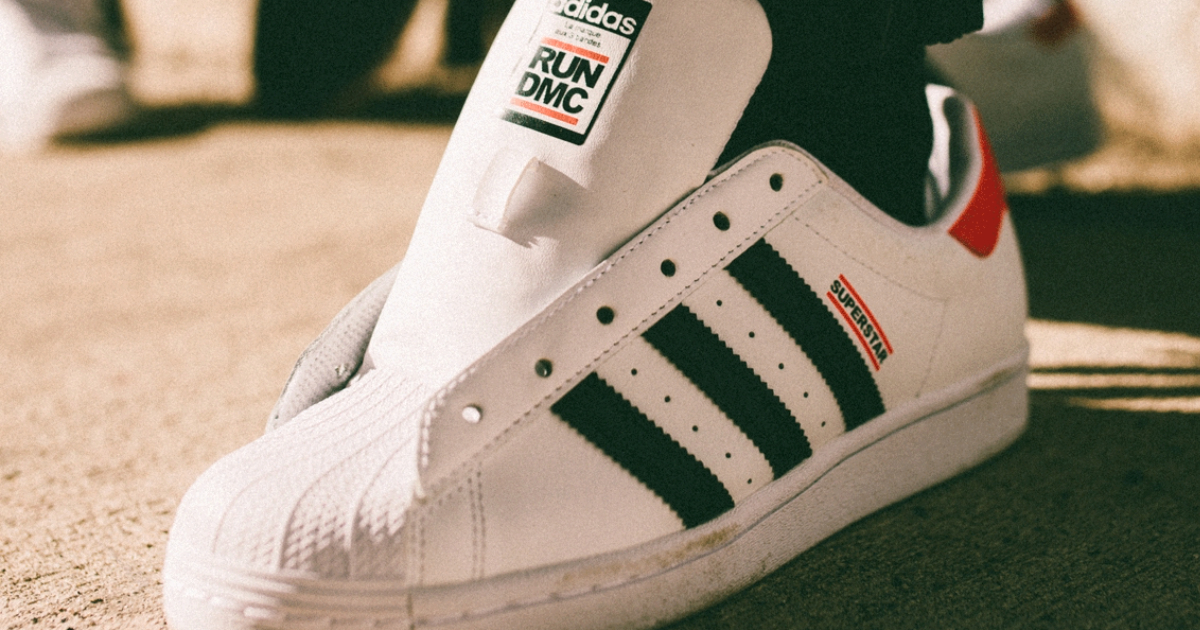
Run-DMC 35th anniversary Adidas Superstar collaboration, 2020.
